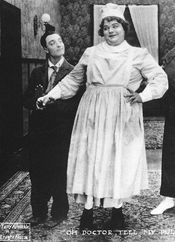The following is my entry in The Silent Cinema Blogathon, being hosted Oct. 24-26, 2015 by the blog In the Good Old Days of Classic Hollywood. Click on the above banner to visit the blogathon and read an assortment of great blogs related to the era of silent movie classics!
(WARNING: Major spoilers abound!)
Duck Soup‘s interest for movie academics might be more historical than hysterical. Yet even on that basis, it’s as worthy of L&H buffs’ attention as Unknown Chaplin is to Charlie Chaplin fans, or The Beatles Anthology is to Fab Four aficionados. It’s a worthy addition to the L&H canon, and it helps make our mental image of them more complete.
For years Duck Soup was a lost movie, and it was assumed the film was one of Stan and Babe’s back-burner Pathe numbers, where they each performed in the movie but not as a team. Then a print turned up in the 1970’s and showed that Stan and Ollie were (or should have been) a bonafide team from the start. Ollie badly needs a shave, but other than the vagabond garb, Stan and Ollie were far closer to the way we now “know” them then they were in their other Hal Roach/Pathe productions. Why they “began” as a team and then went back to doing separate appearances in the same movie remains one of movie comedy’s great unanswered questions.
But there’s enough recognizable “Stan and Ollie” byplay to warrant at least one viewing. For one thing, Duck Soup is the quite recognizable origin of its talkie version, Another Fine Mess (1930). Both films were based on an old vaudeville sketch written by Stan’s dad (though Pop later complained loudly about what his son had done to the source material).
Duck Soup shows Stan and Ollie on the run from local police, though unlike the talkie version, they are not trying to avoid arrest but are instead trying to avoid the zeal of a sheriff looking for help in putting out a forest fire (Was this a common kind of recruitment in 1920’s Los Angeles?). In later films (with their personas more firmly established), whenever Stan and Ollie are on the run from the law, it’s usually due to their fear of authority figures. Here, the cause is just plain laziness.
Anyway, Stan and Ollie hide out in a millionaire’s mansion, and as luck would have it, the millionaire is out of town and has advertised for boarders to rent the house. Ollie and Stan quickly assume the disguises of the millionaire and his maid.
And “quickly” is the key word here. The most unrecognizable element in this L&H film is its frenetic pace, making it closer to typical Hal Roach/Pathe fare than to the later, more leisurely paced L&H shorts. Also, there are no particularly memorable “set pieces” here — unlike Another Fine Mess, where Ollie revels in his disguise, or Stan has a hilarious conversation with the wife of the would-be boarder (Thelma Todd).
Yet it still makes for fascinating viewing, not least because of its view of a surprisingly undeveloped ’20s Los Angeles. The movie also shows that even from the beginning, Stan and Ollie intuitively worked as a team–it just took their own movies a little while longer to figure that out.
TRIVIA NOTE: Duck Soup proved to be an especially sturdy movie title. Six years after Laurel & Hardy used it, former L&H associate Leo McCarey nabbed it for his classic Marx Bros. movie; nine years later, Hal Roach nabbed it back for an Edgar Kennedy short subject. Maybe Judd Apatow will be using it next.





















